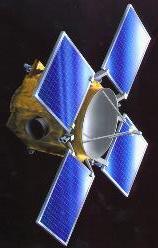
Progress Report: 21Jul99
Task:
Process:
Jessica: I made a sequence for the high mass case. My .REQ files for the high mass case can be found in hermes.earth.nwu.edu:/work2/jedmonds/orbit/100k/high_mass/1by3_lon_sequence. To see a model of the asteroid using all the unaltertered 5.5 hour periods, click here. (the colors on the model describe the emission angle -- purple is 0, green is about 45, and red is 90) I made plate models of the whole asteroid using all but one 5.5 hr orbit (these models can be found in hermes.earth.nwu.edu:/work2/jedmonds/orbit/100k/high_mass/minus_orbits), so that I could see if altering any one period would significantly worsen any part of the image. Notes on observations of these missing periods are in hermes.earth.nwu.edu:/work2/jedmonds/orbit/100k/high_mass/minus_orbits/missing_orbit.README.
Then I took each of the periods that did NOT significantly affect the image, and altered each of their aimpoints to get good emission angle on problem areas. I made plate models of the whole asteroid with just the one period altered (these plate models, as well as individual off-nadir .REQ files, are found inhermes.earth.nwu.edu: /work2/jedmonds/orbit/100k/high_mass/off_nadir_5.5s). Notes on observations of these altered periods are in a hermes.earth.nwu.edu:/work2/jedmonds/orbit/100k/high_mass/off_nadir_5.5s/README. To see an example of one altered orbit, click here.
I combined two and then three of these periods in many combinations, and noted my results. There are notes about the two 5.5 hr off-nadir period runs at hermes.earth.nwu.edu:/work2/jedmonds/orbit/100k/high_mass/2_off_nadir/README, and notes about the three 5.5 hr off-nadir period runs at hermes.earth.nwu.edu:/work2/jedmonds/orbit/100k/high_mass/3_off_nadir/README. To see a picure of the best three period alteration, click here.
Finally, I combined seven, then nine, then eleven 5.5 hour periods to see what kind of coverage I could get using these minimumu numbers. These plate models, as well as descriptive README files to explain how I reasoned these models, can be found in hermes.earth.nwu.edu:/work2/jedmonds/orbit/100k/high_mass/7_periods, hermes.earth.nwu.edu:/work2/jedmonds/orbit/100k/high_mass/9_periods, and hermes.earth.nwu.edu:/work2/jedmonds/orbit/100k/high_mass/11_periods. To see a picture of the image in which nine periods was used, click here.
Emily: I did almost exactly what Jessica did, except that I did it for the low mass case. Also, I only did one sequence off-nadir and three sequences off nadir. All of my files are in hermes.earth.nwu.edu:/work2/epeters/orbit/100k/low_mass/1by3_req or hermes.earth.nwu.edu:/work2/epeters/orbit/100k/low_mass/1by3_fp. All the REQ files are in the first one; all the plate models and frames are in the second one. My README file is at hermes.earth.nwu.edu:/work2/epeters/orbit/100k/2nd_scenario/README
Findings:
Emily: I found that it was best to point off-nadir for the periods of 104:19(5/330/0), 101:13(4/330/0) and 105:08(3/150/0). Information about how I did this is in the aformentioned README file.
(Emily Peters and Jessica Edmonds, 7-21-99)